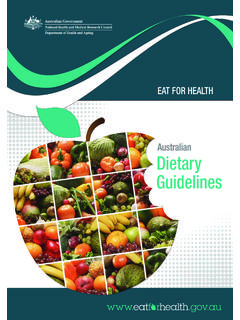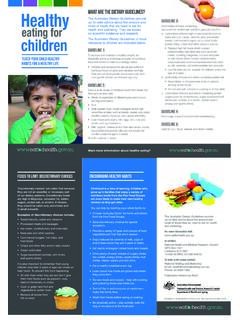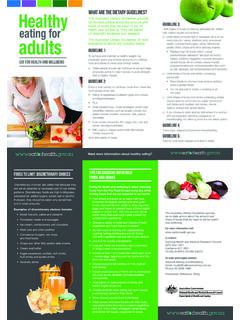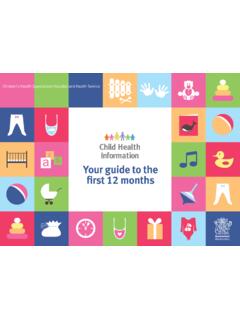Transcription of Eat for Health Infant Feeding Guidelines Summary
1 EAT FOR HEALTHI nfant Feeding GuidelinesSUMMARYEAT FOR HEALTHI nfant Feeding GuidelinesInformation for Health workersSUMMARYP ublication DetailsPublication title: Infant Feeding Guidelines : SummaryPublished: February 2013 Publisher: National Health and Medical Research CouncilNHMRC Publication reference: N56bOnline version: Online: 1864965827 ISBN Print: 1864965819 Suggested citation: National Health and Medical Research Council (2012) Infant Feeding Guidelines : Summary . Canberra: National Health and Medical Research : This document is a general guide to appropriate practice, to be followed subject to the clinician s judgement and patient s preference in each individual Commonwealth of Australia 2016 All material presented in this publication is provided under a Creative Commons Attribution International licence ( ), with the exception of the Commonwealth Coat of Arms, NHMRC logo and any content identified as being owned by third parties.
2 The details of the relevant licence conditions are available on the Creative Commons website ( ), as is the full legal code for the CC BY International Commons Attribution International Licence is a standard form licence agreement that allows you to copy, distribute, transmit and adapt this publication provided that you attribute the work. The NHMRC s preference is that you attribute this publication (and any material sourced from it) using the following wording: Source: National Health and Medical Research of imagesUnless otherwise stated, all images (including background images, icons and illustrations) are copyrighted by their original usTo obtain information regarding NHMRC publications or submit a copyright request, contact:E: P: (02) 6217 9000 Infant Feeding Guidelines : Summary ivCONTENTSHow to use this resource 1 Disclaimer 1 Overview 2 breastfeeding 3 Promotion of supportive social and physical environments for breastfeeding 4 Special considerations 6 When an Infant is not receiving breastmilk 7 Other fluids in Infant Feeding 9 The transition to solid foods 10 After 12 months 12 Caring for infants food 13 Nutrition in the second year of life 14 Other aspects of Infant nutrition 15 Food allergies 15 Colic
3 15 Constipation 16 Dietary fat 16 Dental caries 17 Diarrhoeal disease 18 Infant Feeding Guidelines : Summary 1 How to use this resourceThis document provides a Summary of the Infant Feeding Guidelines from the NHMRC s Eat for Health Program published in Infant Feeding Guidelines are aimed at Health workers to assist them in providing consistent advice to the general public about breastfeeding and Infant Feeding . They support optimum Infant nutrition by providing a review of the evidence, and clear evidence-based recommendations on Infant Feeding for Health main recommendations for Infant Feeding , including the introduction of solid food, are briefly described in this Summary . The full text of the Infant Feeding Guidelines can be downloaded from DisclaimerThe Infant Feeding Guidelines and the information in this Summary are relevant to healthy, term infants of normal birth weight (>2500g).
4 Although many of the principles of Infant Feeding described here can be applied to low birth weight infants, specific medical advice is recommended for pre-term and underweight infants. This document is a general guide to appropriate practice, to be followed subject to the clinician s judgement in each individual case. The Infant Feeding Guidelines are designed to provide information to assist decision-making and are based on the best information available to the date of Health and Medical Research Council2 OverviewAustralia is a nation in which breastfeeding is protected, promoted, supported and valued by the whole of society. breastfeeding provides major public Health benefits. The nutrition and growth of infants has an important effect on early morbidity and mortality and there is increasing evidence of the medium and long-term effects on Health .
5 Infant growth is now recognised as one of the influences on Health and longevity later in life and breastfeeding is the backbone of early Health workers should promote breastfeeding in the community and ensure that best practice in breastfeeding is followed. When mothers choose to use Infant formula it is also best practice to provide them with all of the information and support that they need. The Marketing in Australia of Infant Formulas: Manufacturers and Importers Agreement (MAIF) is based on the WHO International Code of Marketing of Breast-milk Substitutes (the WHO Code) and provides the basis for control of the marketing of Infant formula in Australia. Australia s breastfeeding initiation rate is good at 96%. However, only a small proportion of women achieve the goal of exclusively breastfeeding to around 6 months. The role of Health workers in supporting breastfeeding is important to further increase Australia s breastfeeding initiation and duration rates.
6 This Summary provides background information and recommendations that will help Health professionals support parents and promote the above Feeding Guidelines : Summary 3 BreastfeedingBreastfeeding is the healthiest start for infants. breastfeeding confers protection against infection, some chronic diseases including type 1 and type 2 diabetes, coeliac disease and inflammatory bowel disease, is associated with lower cardiovascular disease risk factors including high blood pressure and elevated total and LDL cholesterol and obesity. breastfeeding also contributes to improved cognitive development. There are also maternal benefits, with evidence for a reduced risk of ovarian and breast cancer, as well as a reduced risk of developing type 2 diabetes among women with a history of gestational diabetes. In Australia, it is recommended that infants be exclusively breastfed until around 6 months of age when solid foods are introduced.
7 It is further recommended that breastfeeding be continued until 12 months of age and beyond, for as long as the mother and child desire. While many mothers encounter some difficulties with breastfeeding , usually these can be overcome with support and encouragement from Health professionals, family and community organisations. Many mothers can also continue breastfeeding if they choose to return to work. While exclusive breastfeeding is ideal, any amount of breastmilk is beneficial to the Infant and mother. If mothers express and store breastmilk, it is important to follow correct procedures to ensure food safety and XEncourage, support and promote exclusive breastfeeding to around 6 months of age. XContinue breastfeeding while introducing appropriate solid foods until 12 months of age and beyond, for as long as the mother and child desire.
8 XWhile breastfeeding is recommended for the first 6 to 12 months and beyond, any breastfeeding is beneficial to the Infant and Health and Medical Research Council4 Promotion of supportive social and physical environments for breastfeeding The active promotion and support of breastfeeding by community Health , lay and peer organisations, primary Health care services, hospitals, and workplaces will increase the proportion of women breastfeeding (both exclusive and non-exclusive) up to age 6 months. The implementation of the Baby Friendly Hospital Initiative may also improve breastfeeding and effective positioning at the breast and correct attachment and milking action are vital for the efficient removal of milk from the breast without nipple pain or trauma. Antenatal education on positioning and attachment technique is recommended to prevent or reduce any nipple pain associated with use of a pacifier before 4 weeks of age may also be associated with a reduced duration of breastfeeding (any, predominant and exclusive).
9 Recommendations for individuals XProvide antenatal information and counselling about the benefits and practical aspects of breastfeeding (and the risks of not breastfeeding ) to all potential mothers, fathers and primary carers. XPay particular attention to positioning and attachment when advising on breastfeeding . XTake steps to identify breastfeeding difficulties by asking appropriate questions during any Health -related visits with the mother. Manage those difficulties if appropriately qualified, or refer to a Health professional for management ( lactation consultant). XProvide postnatal breastfeeding support information. XA pacifier (dummy) may be offered, while placing Infant in back-to-sleep-position, no earlier than 4 weeks of age and after breastfeeding has been Feeding Guidelines : Summary 5 Recommendations for creating a supportive environment XPromote the principles of the Baby Friendly Hospital Initiative.
10 XEncourage caregivers to access community-based services supporting breastfeeding families: such services are of increasing importance as the length of hospital stays decrease. XEncourage support in the community and workplace for flexible work schedules, suitable environments for breastfeeding , expressing breastmilk, storage of expressed breastmilk and child care. Encourage the use of available paid parental leave schemes and lactation break entitlements. XContinue to implement the WHO International Code of Marketing of Breast-milk Substitutes and the Marketing in Australia of Infant Formulas: Manufacturers and Importers Agreement and ensure that all Health professionals understand their Health and Medical Research Council6 Special considerationsThere are very few contra-indications for breastfeeding . Maternal and paternal smoking is negatively associated with breastfeeding duration and predominant or exclusive breastfeeding , but smoking and environmental contaminants are not valid reasons to stop breastfeeding .







